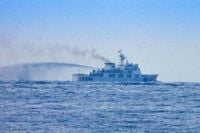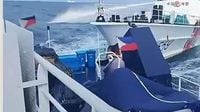On Sunday, October 12, 2025, tensions in the South China Sea erupted yet again as the Philippines and China traded sharp accusations over a maritime confrontation that saw a Chinese coast guard vessel use a water cannon and ram a Philippine government ship near the disputed Thitu Island. The incident, which left the Filipino vessel with minor structural damage but no reported injuries, has become the latest flashpoint in a region where sovereignty claims have simmered for decades and frequently threaten to boil over.
According to official statements from Manila, the Philippine Bureau of Fisheries and Aquatic Resources ship, the BRP Datu Pagbuaya, was anchored off Thitu Island (known locally as Pag-asa and as Zhongye in China) as part of a government program to support and protect local fishermen. At 9:15am local time (01:15 GMT), a Chinese coast guard vessel bearing bow number 21559 reportedly approached and fired a powerful water cannon directly at the Filipino ship, striking both the hull and the two Philippine flags flying aboard. Just three minutes later, the same Chinese vessel rammed the stern of the BRP Datu Pagbuaya, causing minor damage but, fortunately, sparing the crew from harm, as reported by the Philippine Coast Guard and confirmed by video evidence released to the public (Reuters, France 24, The Independent).
The Philippine Maritime Council, an inter-agency government body, issued a strong condemnation of what it described as Chinese maritime forces “deploying water cannon and ramming a Filipino vessel near the Philippine-occupied Thitu Island,” vowing to pursue “appropriate diplomatic action” in response (Reuters). Commodore Jay Tarriela, spokesperson for the Philippine Coast Guard, did not mince words, characterizing the actions as “dangerous and provocative” and as “bullying tactics and aggressive actions.” He added, “Despite these bullying tactics and aggressive actions, the Philippine coast guard and the Bureau of Fisheries and Aquatic Resources remain resolute. We will not be intimidated or driven away.”
Admiral Ronnie Gil Gavan, the Philippine coast guard commandant, echoed the sentiment, stating, “The harassment we faced today only strengthens our resolve. Filipino fisherfolk depend on these waters and neither water cannons nor ramming will deter us from fulfilling our commitment to Pres. Ferdinand Marcos to not surrender a square inch of our territory to any foreign power.” The incident, he insisted, “only strengthens” Manila’s determination to defend its claims and protect its citizens’ livelihoods (The Independent, Al Jazeera).
The Chinese government, for its part, offered a sharply contrasting account. In a statement posted online, Chinese coast guard spokesman Liu Dejun asserted that the incident occurred only after the Philippine vessel “ignored repeated stern warnings from the Chinese side, and dangerously approached” the Chinese ship near Sandy Cay, a coral reef in the northern Thitu Reefs within the Spratly Islands. “Full responsibility lies with the Philippine side,” Liu declared, maintaining that the Filipino vessel “illegally entered” Chinese waters and brought the collision upon itself (France 24, Reuters).
Such confrontations are hardly a rarity in the South China Sea, a region crisscrossed by overlapping territorial claims from China, the Philippines, Vietnam, Malaysia, Brunei, and Indonesia. China asserts sovereignty over nearly the entire sea, a stance dismissed by a 2016 United Nations-backed tribunal ruling, which found Beijing’s claims have no legal basis—a decision China continues to reject. The United States and many of China’s Western and Asian neighbors support the tribunal’s findings, further fueling the diplomatic stakes (Al Jazeera, The Independent).
Thitu Island, the site of Sunday’s incident, is the largest of nine islands, islets, and reefs in the Spratlys occupied by the Philippines. It is home not just to a military outpost but also to a small fishing community whose livelihood depends on access to the surrounding waters. The region’s strategic importance cannot be overstated: more than $3 trillion in annual ship-borne trade passes through the South China Sea, making it one of the world’s busiest and most valuable maritime corridors (Reuters, France 24).
China has in recent years transformed seven barren reefs in the Spratlys into fortified island bases, three of which now boast runways. Subi Reef, one of these artificial islands, lies just over 20 kilometers (12 miles) from Thitu. The proximity of these heavily militarized outposts has only heightened anxieties among Filipino residents and their government, who see Beijing’s construction activities as a direct threat to their own security and sovereignty (The Independent).
This latest maritime clash comes at a particularly fraught moment for the Philippines. President Ferdinand Marcos Jr.’s administration is already grappling with a series of domestic emergencies, including deadly earthquakes that recently killed more than 80 people in the central and southern parts of the country, as well as back-to-back typhoons that left widespread devastation in their wake. Despite these challenges, officials in Manila have signaled no intention of backing down in the South China Sea. “Manila will not surrender a square inch of our territory to any foreign power,” Commodore Tarriela reiterated (The Independent, Al Jazeera).
The United States, a longtime treaty ally of the Philippines, weighed in swiftly. U.S. Ambassador to the Philippines MaryKay Carlson condemned what she called China’s “dangerous ramming” of the Filipino vessel and described the incident as “aggressive actions” in the South China Sea. The U.S. has consistently backed the Philippines in previous stand-offs and has called for respect for international law and freedom of navigation (Reuters).
Sunday’s incident is only the latest in a series of recent flare-ups between Beijing and Manila. Just last month, a water cannon attack by a China Coast Guard vessel shattered a window on the bridge of another Philippine fisheries bureau ship, the BRP Datu Gumbay Piang, near the Beijing-controlled Scarborough Shoal, injuring one person. In August, a Chinese navy vessel even collided with one of its own coast guard ships while chasing a Philippine patrol boat in the same area. The Scarborough Shoal, another flashpoint, was seized by China from the Philippines in 2012 after a lengthy standoff, and Manila has since accused Beijing of using environmental protection as a pretext for occupation (France 24).
As the South China Sea dispute continues to roil regional politics and endanger the livelihoods of thousands of fishermen, the world watches closely. Each new incident—whether a water cannon blast, a ramming, or a diplomatic protest—adds another layer to a conflict that shows little sign of resolution. For now, the resolve of both sides remains unshaken, and the waters around Thitu Island are as contested, and as perilous, as ever.






